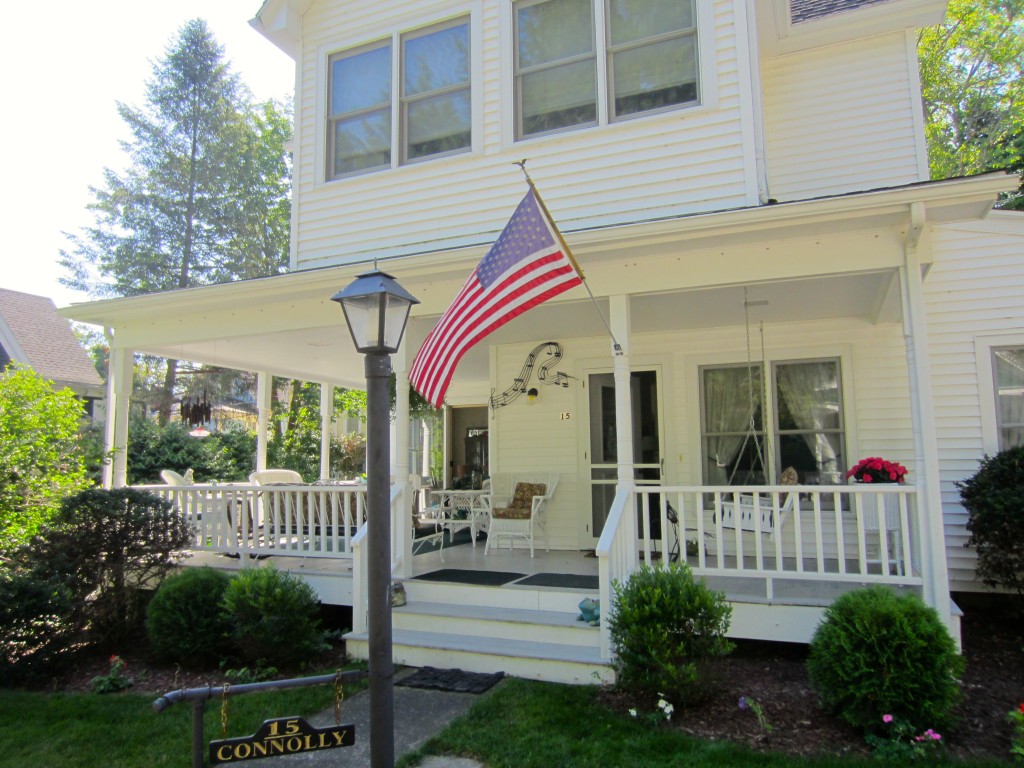Chautauqua 2014: the American West

Once more we were fortunate to be invited to spend a week with Jack and Peg at Chautauqua in western New York. Angela and Henry came, too, and for the first time, Lilli and Violet. These photos show what a good time we all had, especially the photogenic Violet. While she was in school each morning, we adults attended lectures about the American West. Let me introduce the speakers who challenged our minds each morning and gave us plenty to discuss at dinner. My detailed lecture notes may be downloaded below.
Monday 21 July: America as Frontier: A View of Our Past, by Patrick Griffin, Chair, University of Notre Dame Department of History. Steve and I were fascinated to hear him say that we must look eastward to Britain and its relation to Ireland and Scotland for the model of how Americans treated Indians. The Brits regarded the Irish and Scots on its frontiers as uncivilized, uncouth, inferior and beyond redemption, and castigated their reliance on whisky. To secure their flanks they employed cruel, despoiling violence; the Battle of Culloden in 1746 was particularly brutal. During the French-Indian War beginning in 1763, General Amherst resorted to biological warfare against the Pontiacs, giving them blankets used in a small-pox hospital, an act that sealed their fate. In the 19th century British attitudes changed to reforming and civilizing Scots and Irish, but in America Andrew Jackson removed even the Five Civilized Tribes. Griffin cited John Ford’s film, “The Man Who Shot Liberty Valance,” for its depiction of contrasting attitudes. John Wayne’s character personifies the violence of western expansion; Jimmy Stewart represents the reformer.
Tuesday, 22 July: Cynthia Truelove, Director/Visiting Scholar, Water-Energy Policy Research Initiative, Program for Water in the West, Woods Institute for the Environment, Stanford University, spoke on the importance of integrating water and energy resources. Native Americans understood the need to consider resources holistically, even spiritually. Whites began to split them for fast gains at high cost. In California crises have motivated change. A steam leak in two nuclear reactors in 2012 shut down 20% of the power in Southern California. Since January 2014 there has been a 20% decrease in the Sierra snowpack, a principal source of water. This shortfall is already causing wildfires and costing billions. “Politicians need to move from maintaining positions to meeting urgent needs.”
Wednesday 23 July: Museums of the American West in the 21st Century: Transformational Journey in Interpretation,” by W. Richard West, Jr., president and CEO, Autry National Center of the American West. West, a member of the Cheyenne and Arapaho tribes, was a founding director of the Smithsonian’s National Museum of the American Indian (NMAI), which opened in 2004. I’ve visited the NMAI many times, but after his lecture I want to go back. He called it a “safe place for unsafe ideas,” rather than a “Temple of the Arts.” Housing a collection of Native artifacts covering the entire Western hemisphere, it originated in the multiculturalism of the 1980s. The Autry Center in Los Angeles, is inter-cultural, seeking to tell all the stories of the American West. Now I want to see the Autry, as well as two others–the Heard Museum in Phoenix and the Fenimore Art Museum in Cooperstown NY. West ended his lecture with a benediction in the Cheyenne language.
Thursday 24 July: The Politics of the American West, Bruce Babbitt, former governor, Arizona; Robert List, former governor, Nevada; Juliet Eilperin, White House reporter, The Washington Post. See detailed notes.
Friday 25 July: Forces Shaping Silicon Valley, Leslie Berlin, Project Historian, Stanford’s Silicon Valley Archives. Berlin has written a book about Robert Noyce, co-inventor of microchip technology and consulted on a PBS special on the Silicon Valley. As an aside, she reported enjoying Stewart O’Nan’s Emily, Alone and others of his novels set in Chautauqua.
As Leslie was introduced, Steve turned to me and remarked “You and I were almost Silicon Valley pioneers!” When we were planning our wedding in 1966, in the infancy of the computer industry, he was ready to accept a job offer from Sylvania Electronics in Mountain View CA. Then his scholarship to Harvard Business School came through and we headed for Boston instead. I wonder how our lives might have been different?
One afternoon we heard Tink Tinker’s arresting challenge to traditional American history; my notes are posted on How the West Was Lost. Nighttime concerts by the Chautauqua Symphony Orchestra and performances by the Charlotte NC Ballet Company showcased artistic aspects of the American West. My class on Western movies taught me new ways of looking at film. We saw the “Ballad of Baby Doe” opera that echoed our trip to Leadville in June and got to meet the title soprano, Cree Carrico.
Best of all was the collaboration of all Chautauquan artists–dancers, singers, orchestra musicians, opera and theater students–in a presentation entitled “Go West,” a two-hour pageant of the American West on Saturday evening. It featured very innovative staging and kept us all enthralled, even Violet, who lasted almost to the end.
Thank you, Peg, Jack, Angela, Henry, Steve, Lilli and Violet for being such adaptable, fun companions. It was a memorable week.
Leave a Reply